Test geek and founder of Aptitude-Test-Prep.com
What Is the Delta Airlines Flight Attendant VJT Test?
The Delta Airlines VJT (Virtual Job Tryout) Test is a versatile assessment used as the initial screening stage for Delta flight attendants.
Generally speaking, VJT is a type of test that aims to virtually simulate actual experiences on the job. As such, you will face various tasks that simulate the everyday work of a flight attendant.
The test contains 6 sections, described briefly below. In the next paragraph we will describe each of these sections in detail.
- Handle Work Challenges – 7 most-least SJT questions.
- Serve Your Passengers – 4 rather complex problem-solving questions based on 3 resources.
- Understand Passengers – 5 questions that require recognizing emotions expressed in 20-second audio recordings.
- Tell Us Your Story – 20 biodata questions in 3 minutes.
- Recall Passenger Needs – 5 memory questions based on the audio recordings in section 3.
- Describe Your Approach – 48 personality profiling questions.
For preparation, we strongly recommend JobTestPrep’s Delta VJT Prep Course – the only course that provides an authentic practice experience, tailored for the actual test.
Full Disclosure: We are affiliated with JobTestPrep. Clicking the links helps us provide you with high-quality, ad-free content.
Test Structure and Question Format
Below is a detailed overview of all 6 Delta VJT test sections, including sample questions. For more sample questions, check out the Free Practice section.
Section #1 – Handle Work Challenges
- What It Measures: Expected behavior on the job
- Questions: 7
- Recommended Time: 10 minutes
- Question Format: You are presented with a scenario you might face as a flight attendant and 4 possible responses. You should select how you are MOST and LEAST likely to respond.
In this section, you will first be presented with the scenario and the 4 responses, of which you need to choose how you are MOST and LEAST likely to respond:
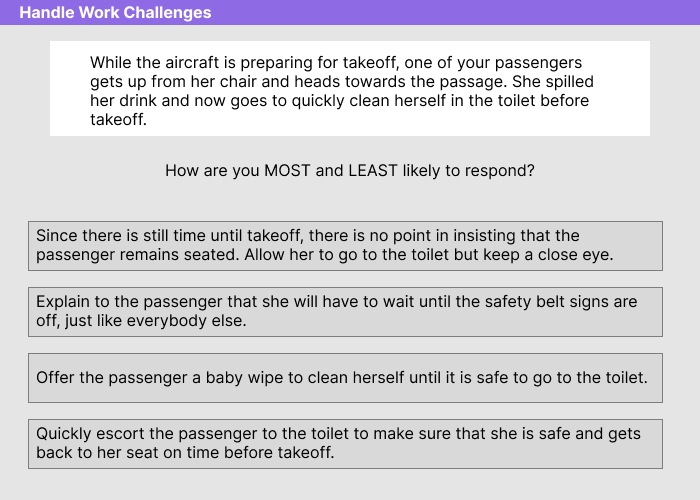
How Should You Answer This Question?
- Most – Response #3
- Least – Response #1
Whenever answering a question on this section of the test, always try to look at the possible responses from the two following aspects:
- Does it solve the problem?
- Does it provide good service?
Let’s look at the given statements:
Since there is still time until takeoff, there is no point in insisting that the passenger remains seated. Allow her to go to the toilet but keep a close eye.
While this response solves the passenger’s problem, it does not solve the main problem of the scenario, as it violates safety regulations. In addition, simply turning a blind eye to a passenger putting herself in danger cannot be considered good service.
This is the LEAST recommended response.
Explain to the passenger that she will have to wait until the safety belt signs are off, just like everybody else.
This response solves the safety regulation problem but does not address the passenger’s problem. In addition, it is somewhat harsh and does not provide good, friendly service. While it is an unrecommended response, it still isn’t AS bad as response #1, which directly violates safety regulations.
Offer the passenger a baby wipe to clean herself until it is safe to go to the toilet.
This response both solves the problem (perhaps not entirely, but at least in part), while also showing care for the passenger’s need and providing good service.
This is the MOST recommended response.
Quickly escort the passenger to the toilet to make sure that she is safe and gets back to her seat on time before takeoff.
This response provides caring service but does not solve the problem by, again, directly violating safety rules. It is not as bad as response #1, but it is still an unrecommended response.
In the Free Practice section, we provide some additional, more challenging examples.
Section #2 – Serve Your Passengers
- What It Measures: Problem-solving and cognitive ability (numerical, verbal, spatial).
- Questions: 4
- Recommended Time: 6 minutes. The faster, the better.
- Question Format: Solve on-the-job problems based on data in 3 different aviation-related resources.
The “Serve Your Passengers” section is the only cognitive section of the Delta VJT test. It will present you with 3 data resources:
- Numerical – a graph or table with numerical data
- Verbal – a medium-length text
- Visual – a map of plane seats.
You will then be required to solve problems based on the information in these data sources.
Here’s a sample question:
A passenger in seat 12B asks you to be moved to a window seat. How many rows will you move the passenger?
- 1 row
- 2 rows
- 4 rows
- No window seat is available.
Answer and Explanation
The correct answer is C.
Since the only free window seat is 8A, the passenger will move 4 rows.
The sample question above is very simple. The questions in the Delta VJT Test will require you to integrate several resources. To make sure you are prepared for such questions, consider authentic preparation materials.
Section #3 – Understand Passengers
- What It Measures: Empathy
- Questions: 5
- Recommended Time: 3 minutes
- Question Format: You are presented with a brief audio and then asked to choose the conveyed emption.
In this section, you will listen to a short audio (approx. 20 seconds long) of a passenger speaking. Then, you will be requested to recognize the emotion expressed by this passenger out of 4 possible options.
Pro Tip
You should pay close attention to what the passengers are saying, since you will be asked about it in section #5 – Recall Passenger Needs.
Section #4 – Tell Us Your Story
- What It Measures: Personal background
- Questions: 20
- Recommended Time: 3 minutes
- Question Format: Multiple-choice questions regarding your job experience and behavior.
In this section, which is kind of a biodata questionnaire, you will be asked several questions about your employment experience, behavior, and relationships.
Section #5 – Recall Passenger Needs
- What It Measures: Memory
- Questions: 5
- Recommended Time: 4 minutes
- Question Format: Multiple-choice questions regarding the content of audio in section #3.
In this section, you will be requested to answer questions that refer to things said by the passengers recorded in section #3. These questions are aimed at assessing your short-term memory.
Pro Tip
Two things to note about this section:
- Questions will usually not address any specific passenger, but will start with “One of the passengers…”
- There may be more than one possible answer per question.
Section #6 – Describe Your Approach
- What It Measures: Personality Profile
- Questions: 48
- Recommended Time: 6 minutes
- Question Format: Two conflicting statements describing you, each with two options – ‘Most’ and ‘Somewhat’
The best way to describe the questions in this section is through a simple example.

How to Approach This Question?
Remember that these questions assess your personality traits and how they fit those of an ideal flight attendant.
This specific statement assesses your ability to work in a team. While flight attendants might occasionally be required to make decisions on their own, they are always a part of a team, and are expected to be cooperative.
As such, in this particular statement, Delta will probably expect an answer on the “consult others” side.
This section, along with the first test that precedes the VJT, the TalentBank Personality Test, are aimed at assessing how well your personality fits the ideal profile of a flight attendant. To better understand these desired traits, check out the Delta Flight Attendant VJT Prep Course at JobTestPrep.
What Does the Delta Flight Attendant VJT Test Measure?
The 6 sections of the Delta VJT test measure different aspects of your behavioral traits and cognitive abilities, in order to create a full personal profile. These traits include:
- On-the-job behavior (sections 1, 4)
- Numerical, verbal, and visual ability (section 2)
- Empathy (section 3)
- Memory (section 5)
- Personality profile (section 6)
These scores will be combined with your personal profile as measured in the TalentBank Personality Test, and then compared to Delta’s ideal flight attendant profile.
Test Interface
Here are some quick notes on how the Delta VJT test works:
- Each of the 6 sections is regarded as a separate test, with its own instructions and recommended time limit.
- The test is officially untimed, and therefore no clock appears during the test.
- However, the test instructions provide a recommended solving time for each section, which you should aim to comply with, if possible.
- You cannot go back once you submit a response.
- You can, however, stop a section in the middle and finish it later.

Free Delta VJT Practice Test
This free practice aims to get you familiar with the test sections on the Delta Flight Attendant VJT test, and how you should approach these questions.
2-3 sample questions of each section are provided (except for section #4). For a more extensive preparation, check out the Delta VJT Prep Course.
Good luck!
Question 1 (Handle Work Challenges)
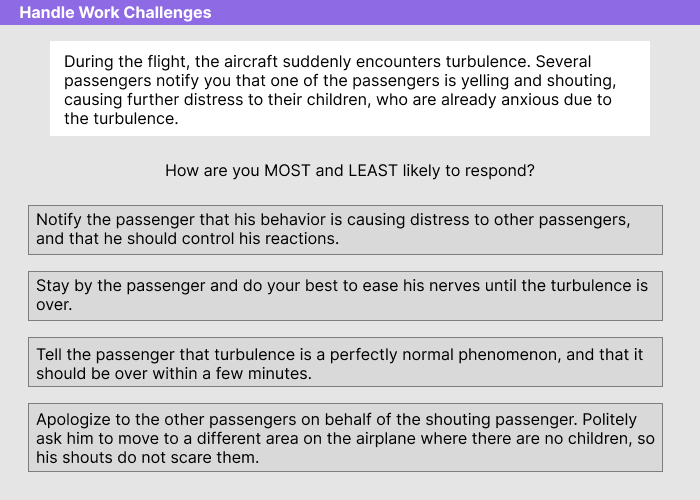
Answer and Explanation
- Most – Response #2
- Least – Response #1
Let’s look at the given statements:
Notify the passenger that his behavior is causing distress to other passengers, and that he should control his reactions.
This response completely lacks empathy and does not solve the problem. The passenger shouts because he is anxious and afraid, and harsh demands are not likely to help him overcome his fear.
This is the LEAST recommended response.
Stay by the passenger and do your best to ease his nerves until the turbulence is over.
This response is empathic and is most likely to solve the problem. Going out of your way to help someone in distress and being present through the situation is likely to calm down both the passenger and the children.
This is the MOST recommended response.
Tell the passenger that turbulence is a perfectly normal phenomenon, and that it should be over within a few minutes.
This response shows an attempt to help the passenger, but providing reasonable explanations lacks empathy, and is therefore not likely to soothe the passenger’s fears.
Apologize to the other passengers on behalf of the shouting passenger. Politely ask him to move to a different area on the airplane where there are no children, so his shouts do not scare them.
This response will solve the complaints of the other passengers, but is likely to offend the shouting passenger, who is likely to be embarrassed by you apologizing on his behalf and requesting him to move to another seat, all while scared by the rapid movements of the aircraft.
This is an unrecommended response, but since it will solve at least a part of the problem, it is not AS bad as response 1.
Question 2 (Handle Work Challenges)

Answer and Explanation
- Most – Response #4
- Least – Response #3
Let’s look at the given statements:
Tell the passenger that unfortunately, since she did not pre-order a meal, there is nothing you can do. Suggest she eats only the side dishes.
This is an unrecommended response as it is both unemphatic and does not solve the passenger’s problem. The only thing it serves is for you to shirk responsibility and prove the passenger wrong.
However, this response is not AS bad as response #3.
Apologize to the passenger and offer her a complementary beverage.
This response may look empathic, but it actually does nothing to solve the problem, and is likely to further agitate the passenger by providing them with an irrelevant solution.
And yet again, that response is not AS bad as response #3.
Tell the passenger that you are taking care of the issue. Quietly explain the situation to other passengers who have ordered a vegetarian meal and ask if they are willing to switch.
This response may, eventually, solve the passenger’s problem, but at the expense of other passengers who have appropriately pre-ordered a vegetarian meal.
While in response #1 you shirk responsibility, in this response you delegate that responsibility to other passengers, to avoid an unpleasant situation yourself. Therefore, it is the LEAST recommended response.
Go to the kitchen and see what you can find there to make a vegetarian meal. Get back to the passenger with a list and ask her what she would like.
This response both takes responsibility for the situation and tries to solve the problem in a creative manner. In addition, you show empathy for the passenger by taking the time and effort to provide a solution.
Therefore, this is the MOST recommended response.
Resources for questions 3-5 (Serve Your Passengers)
Resource 1
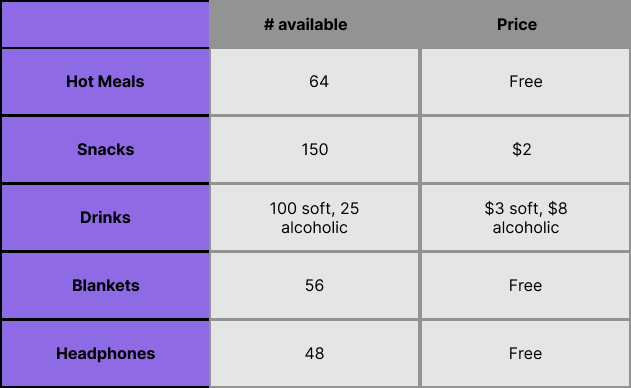
[/su_note]
Resource 2
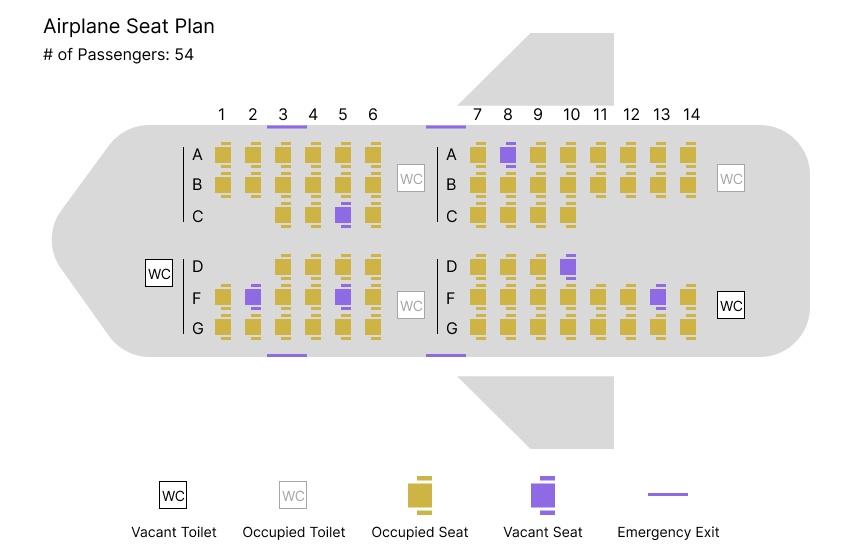
[/su_note]
Resource 3
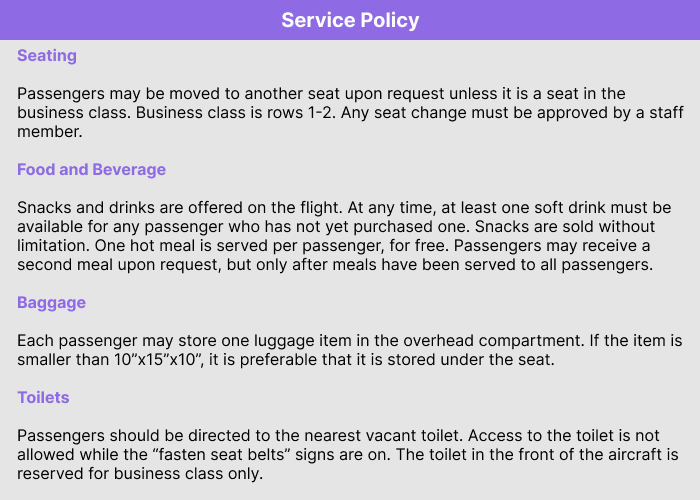
[/su_note]
Question 3
A passenger in seat 6B wishes to use the toilet. To which toilet should you direct him?
- To the toilet in the front of the aircraft.
- To the toilet in the middle of the aircraft.
- To the toilet in the back of the aircraft.
- Either A or C.
Answer and Explanation
The correct answer is C.
Both toilets in the middle of the aircraft are occupied, so the passenger cannot use them. The front toilet is free, but according to the service policy, it is reserved for business class (rows 1-2). Therefore, you should direct the passenger to the toilet in the back of the aircraft.
Question 4
Drinks for a total sum of $281 were sold on the flight thus far. 10 alcoholic drinks were sold. 20 passengers have not yet purchased a soft drink. How many more soft drinks can you sell to passengers who have already purchased one?
- 3
- 13
- 33
- 67
Answer and Explanation
The correct answer is B.
Let’s first calculate the number of drinks sold. Results are shown in the following table:
|
Price |
# sold |
Total |
| Soft |
$3 |
$201 / $3 = 67 |
$281 – $80 = $201 |
| Alcoholic |
$8 |
10 |
$80 |
| Total |
N/A |
77 |
$281 |
According to the Service Policy, “At any time, at least one soft drink must be available for any passenger who has not yet purchased one.”
There are 20 such passengers, so 20 soft drinks should be reserved.
Therefore, the number of soft drinks that can be sold to passengers who have already purchased a soft drink is:
100 – 67 – 20 = 13.
Question 5
The passenger in seat 9C wishes to move to a chair that is closer to the front of the aircraft. How many optional seats can you offer her?
- 2
- 3
- 4
- No available options.
Answer and Explanation
The correct answer is B.
For a passenger in seat 9C, there are 4 available seats that are closer to the front: 8A, 5C, 5F, and 2F.
However, seat 2F is in business class and is, therefore, unavailable for the passenger according to the Service Policy.
Question 6 (Understand Passengers)
This question provides no audio, but demonstrates the types of tasks you will encounter on this section.
Please listen to the audio and choose which emotion you identify:
“I have specifically pre-ordered a special meal, and I was just served the ordinary one with a grilled cheese sandwich. My son is lactose intolerant! Why ask passengers to pre-order if you can’t provide us with what we’ve requested?”
- Angry
- Annoyed
- Factual
- Sad
Pro Tip
You will often be required to distinguish between close emotions, e.g., “Annoyed” vs. “Angry”, or “Pleased” vs. “Happy”.
Question 7 (Understand Passengers)
Please listen to the audio and choose which emotion you identify:
“Excuse me, could you please show me how to put the oxygen mask if air pressure drops? I think I have missed that part in the video. I see it’s also written here in the brochure, but I’d really prefer a live demo.”
- Curious
- Irritated
- Afraid
- Worried
Question 8 (Recall Passenger Needs)
One of the passengers complained regarding a specific ingredient in his meal. Which ingredient was it?
- Cheese
- Meat
- Bread
- Yogurt
Answer and Explanation
The correct answer is A.
The passenger complained about the cheese, since his son was lactose intolerant.
Question 11 (Recall Passenger Needs)
One of the passengers asked you to _______ him how to ________.
- show, find the emergency exit.
- explain, put on the oxygen mask.
- explain, know air pressure was down.
- show, put on the oxygen mask.
Answer and Explanation
The correct answer is D.
The passenger asked for a live demo on how to put on an oxygen mask.
Question 12 (Describe Your Approach)
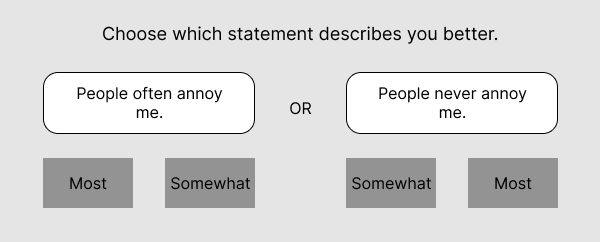
How to Approach This Question?
Flight attendants are constantly required to address passengers’ requests and complaints, maintaining calmness, agreeableness, and good service.
While stating that people never annoy you, may sound unrealistic, remember that your fit will not be based on responses to particular statements, but based on the overall scoring for the relevant personality trait (scale).
For instance, marking “Most” on the right-hand side statement will give you a high score in the agreeableness scale, which is a good idea. However, a score that is unreasonably high may indeed seem unrealistic, and that is expected to be reflected in your profile.
Pro Tip
On section #6, your score is calculated based on the overall profile of your responses, and not based on answers to particular statements. As such, your responses are expected to form a behavioral profile that both fits the flight attendant job but is also realistic and consistent.
Question 13 (Describe Your Approach)

How to Approach This Question?
Since flight attendants are working in a constantly changing, dynamic environment, both in terms of the nature of the work, and in terms of working hours, etc.
As such, Delta would probably prefer candidates who have an innate tendency towards this type of work.
Delta Flight Attendant VJT Preparation
We strongly recommend JobTestPrep’s Delta VJT Test Preparation.
- Tailored Simulations for each of the 6 Delta VJT Sections.
- Detailed answers and explanations to all questions
- Additional study guides for the personality sections
- A money-back guarantee policy
Start Preparing Now
Full Disclosure: We are affiliated with JobTestPrep. Clicking the links helps us provide you with high-quality, ad-free content.
Tips
Considering all the unique features of the Delta Flight Attendant Virtual Job Tryout Test, here are 3 tips for acing it:
Tip #1 – Consider the Job Profile
The majority of the Delta VJT test assesses your personality and behavior. As we’ve previously explained, the traits that emerge from your test answers will be compared with those of an ideal Delta flight attendant.
So, you should have a good understanding of what Delta is looking for before taking the test.
To achieve that, we recommend the following:
- Carefully read the flight attendant job description and identify desirable traits.
- Explore additional resources where Delta describes its flight attendants. Here are two good places to start: Resource 1, Resource 2.
- Read Delta’s values and purpose.
All those are probably going to give you an initial understanding of what Delta expects of its flight attendants. While taking the test, think back to these expectations.
Tip #2 – Consistency in the Behavioral Sections
Sections #1, #5, and #6 in the VJT test, as well as the preceding test, the TalentBank Personality Questionnaire, all assess your predicted personality and behavior on the job.
For Delta to be able to correctly evaluate your character, these sections should align and present similar profiles. Inconsistent profiles over various sections also raise suspicions for lack of authenticity in one’s answers.
Tip #3 – Become Familiar with the World of a Flight Attendant
We’ve started this guide by explaining that the VJT test is basically a virtual simulation of a flight attendant’s work. As such, the content world of a flight attendant will be used in the various situations and data sources provided along the test.
While the test does not require any previous knowledge, being familiar with the terms and policies used in the industry is likely to make you more comfortable during the actual assessment and reduce anxiety.
The Delta Airlines TalentBank Assessment
The Delta TalentBank Assessment (sometimes referred to as Delta Personality Test or Delta Airlines Talent Assessment) is the first screening stage for Delta flight attendants, before the VJT test.
In this section, we will cover the test structure, appearance, and content, to get you familiar with what’s ahead.
What Is TalentBank?
TalentBank is actually the testing platform (i.e., software) of test provider TalentPlus. TalentPlus specializes in what they refer to as “Talent Assessment”, used to uncover candidates’ talents and strengths.
What Is the Delta Airlines Talent Assessment?
The Delta Talent Assessment is a 72-question, untimed behavioral test that uses a large variety of questions to create a profile of a candidate’s talents over 5 categories:
- Drives and Values
- Influence
- People Acumen
- Work Style
- Thought Process
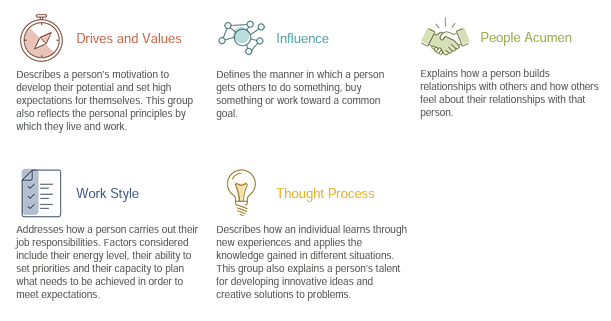
Source.
Delta Airlines Personality Test Questions [+Samples]
While questions on the Delta Airlines Talent Assessment may come in a multitude of formats, they can be divided into two main categories:
- On-a-scale questions
- Behavioral-personality mashup questions
Let’s dive a bit deeper into the test questions, with samples of each question category.
On-a-Scale Questions
These questions may cover various traits and be formulated in many different ways, but what they share in common is that the answers are presented on an increasing scale.
Let’s see some examples:
Sample Question 1
How often do you instruct others regarding professional knowledge or company policies?
- Never
- Rarely
- Sometimes
- Often
- Always
How to Approach This Question?
This question assesses the “Direction” talent in the “Influence” category (see the TalentCard below). This talent refers to one’s ability and will to direct, instruct, and guide others.
While it is a crucial talent for managers and leaders, it is not necessarily a very important one for flight attendants.
Sample Question 2
People at work feel they can share their problems with me.
- Strongly Agree
- Agree
- Neither Agree nor Disagree
- Disagree
- Strongly Disagree
While the scale of this question is structured somewhat differently, it is basically the same question as Sample 1 – only that it assesses a different talent.
How to Approach This Question?
This question assesses the “Relator” talent in the “People Acumen” category (see the TalentCard below). This talent refers to one’s ability and will to relate to others and empathize with them.
For a flight attendant, that is an absolutely essential talent.
Firstly, because flight attendants work as a team for long hours, in challenging environments and hours, and their mutual support and cooperation with team members is highly important for their success.
But even more importantly, flight attendants are customer service professionals. For them to be able to provide good service for passengers, they must be able to empathize and relate.
Behavioral-Personality Mashup Questions
This category of questions provides you with a very brief possible scenario and will ask you to describe how you would respond.
While these are behavioral questions in form (what you will DO), they actually assess your personality (who you ARE).
Here’s an example:
Sample Question 3
When a task is assigned to my team:
- I will be the first one to take it.
- I will take it if my schedule allows me.
- I will wait to see if someone else takes it first.
- I will ask my manager who should take it.
- I will consider who is the best team member for the task.
- I will delegate it to someone.
- I will take it if it doesn’t hurt my progress in my own tasks.
How to Approach This Question?
This question primarily assesses the “Responsibility” talent in the “Drives and Values” category (see the TalentCard below). This talent refers to one’s reliability and trustworthiness.
While this trait is also crucial for a flight attendant, it is important to remember that unlike the on-a-scale question format that was shown previously, this question type is not as straightforward.
Mashup questions may:
- Include several similar answer options.
- Assess additional traits. For instance, in the case above: “Command” (option #6) or “Team” (option #5).
The TalentCard
The TalentCard is the final score report that is produced after you take the Talent Assessment.
A “lean” card will be shared with you, detailing your top 3-5 talents, what they mean, and how to further strengthen them.
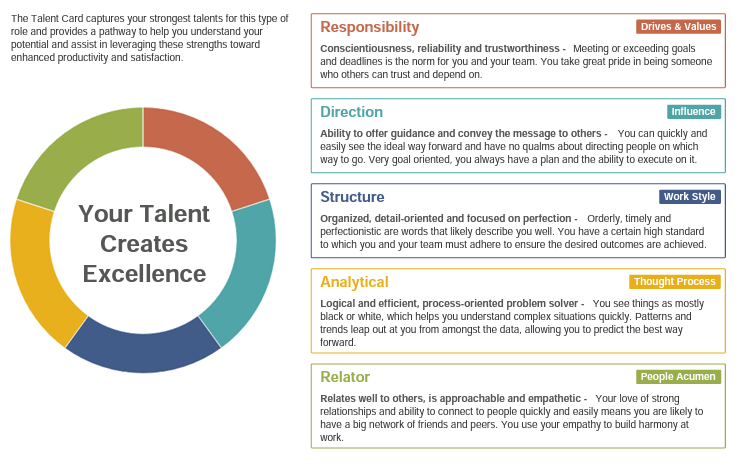
Source.
Your employer will receive a more detailed card, showing all talents that were defined as important for the job, and their scores.
It will look something like this:
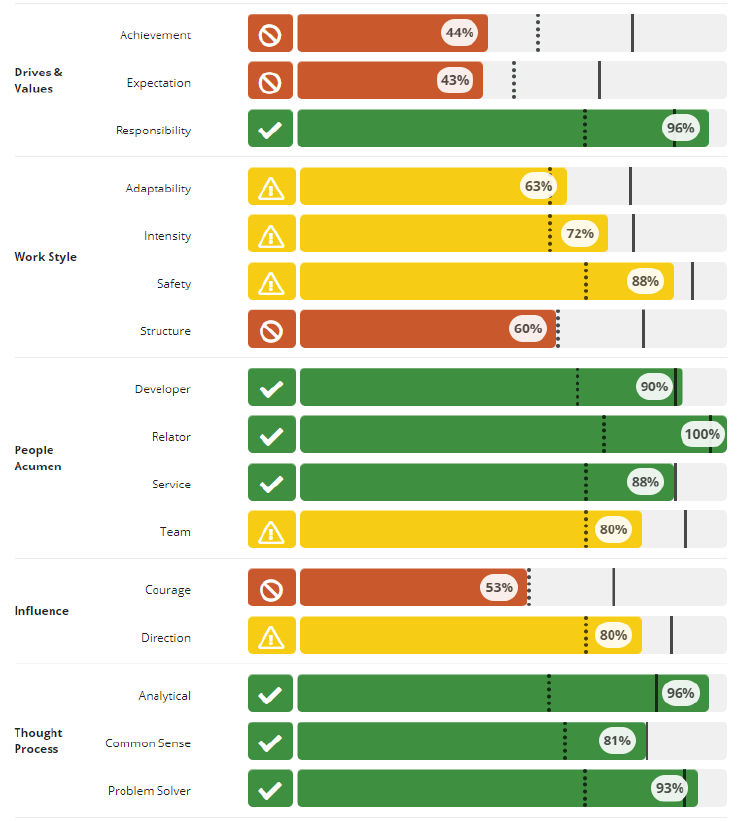
Source.
To learn more about personality tests like the Talent Assessment, you are welcome to check our sister website, Personality-Test-Prep.com.

















